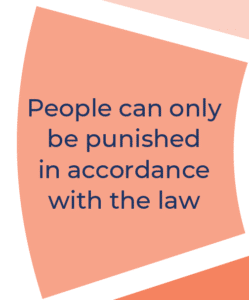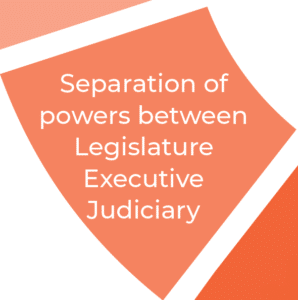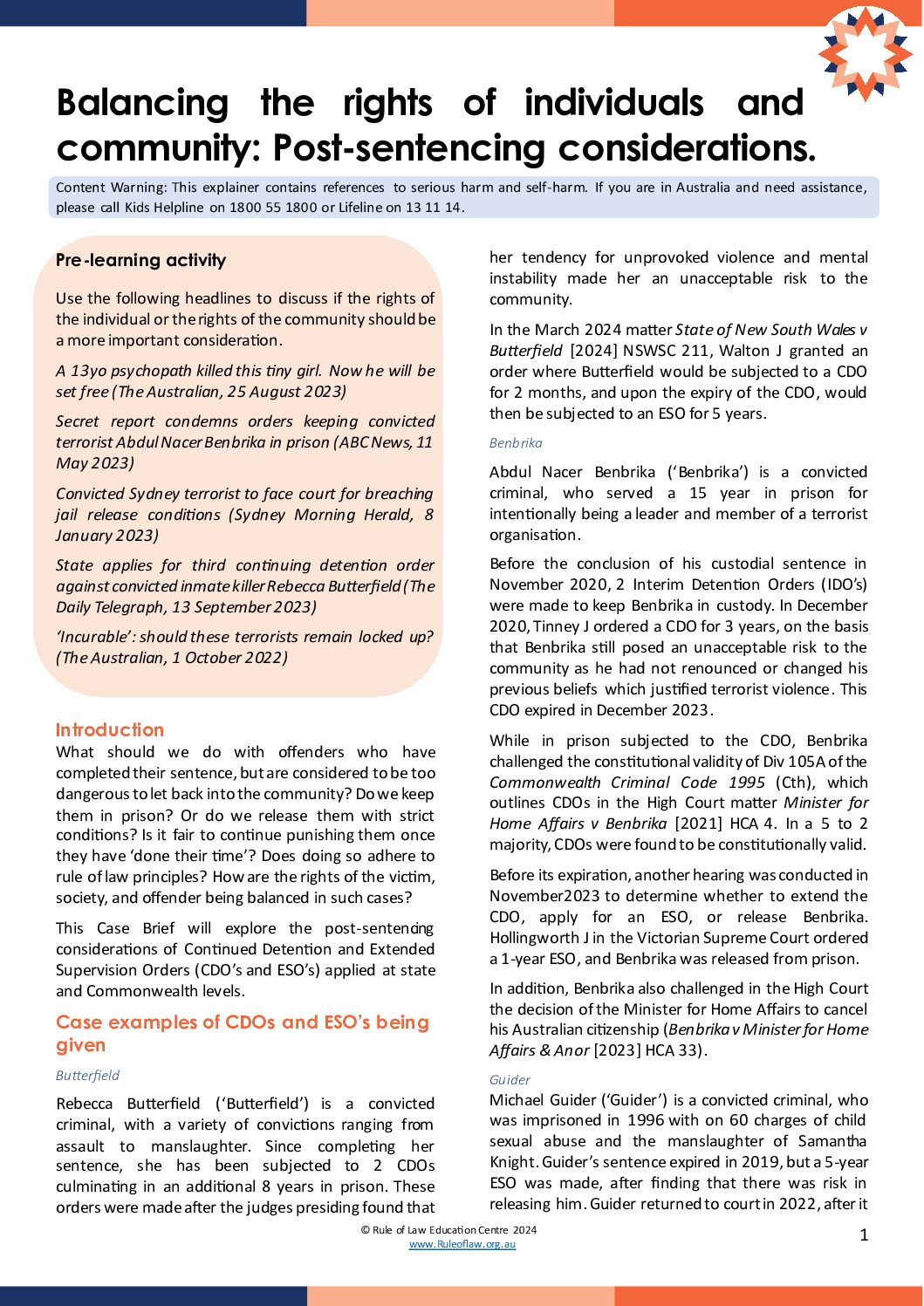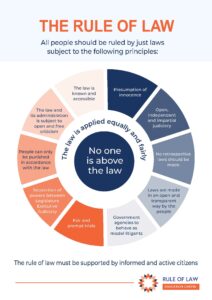Post-Sentencing Considerations
Balancing the rights of individuals and the community
Introduction
Case Examples
P-S Regimes
Legislative Framework
Legal Issues
Statutory Review
Pre-learning activity
Use the following headlines to discuss whether the rights of the individual or the rights of the community should be a more important consideration.
- A 13yo psychopath killed this tiny girl. Now he will be set free (The Australian, 25 August 2023)
- Secret report condemns orders keeping convicted terrorist Abdul Nacer Benbrika in prison (ABC News, 11 May 2023)
- Convicted Sydney terrorist to face court for breaching jail release conditions (Sydney Morning Herald, 8 January 2023)
- State applies for third continuing detention order against convicted inmate killer Rebecca Butterfield (The Daily Telegraph, 13 September 2023)
- ‘Incurable’: should these terrorists remain locked up? (The Australian, 1 October 2022)
Introduction
What should we do with offenders who have completed their sentence, but are considered too dangerous to let back into the community? Do we keep them in prison? Or do we release them with strict conditions? Is it fair to continue punishing them once they have ‘done their time’? Does doing so adhere to Rule of Law principles? How are the rights of the victim, society, and offender being balanced in such cases?
This Case Brief will explore the post-sentencing considerations of Continued Detention and Extended Supervision Orders (CDO’s and ESO’s) applied at state and Commonwealth levels.
Case examples of CDOs and ESO’s being given
Butterfield
Rebecca Butterfield (‘Butterfield’) is a convicted criminal, with a variety of convictions ranging from assault to manslaughter. Since completing her sentence, she has been subjected to 2 CDOs culminating in an additional 8 years in prison. These orders were made after the presiding judges found that her tendency for unprovoked violence and mental instability made her an unacceptable risk to the community.
In the March 2024 matter, State of New South Wales v Butterfield [2024] NSWSC 211, Walton J granted an order where Butterfield would be subjected to a CDO for 2 months, and upon the expiry of the CDO, would then be subjected to an ESO for 5 years.
Benbrika
Abdul Nacer Benbrika (‘Benbrika’) is a convicted criminal, who served 15 years in prison for intentionally being a leader and member of a terrorist organisation.
Before the conclusion of his custodial sentence in November 2020, 2 Interim Detention Orders (IDO’s) were made to keep Benbrika in custody. In December 2020, Tinney J ordered a CDO for 3 years on the basis that Benbrika still posed an unacceptable risk to the community as he had not renounced or changed his previous beliefs which justified terrorist violence. This CDO expired in December 2023.
While in prison subjected to the CDO, Benbrika challenged the constitutional validity of Div 105A of the Commonwealth Criminal Code 1995 (Cth), which outlines CDOs in the High Court matter Minister for Home Affairs v Benbrika [2021] HCA 4. In a 5 to 2 majority, CDOs were found to be constitutionally valid.
Before its expiration, another hearing was conducted in November 2023 to determine whether to extend the CDO, apply for an ESO, or release Benbrika. Hollingworth J in the Victorian Supreme Court ordered a 1-year ESO, and Benbrika was released from prison.
In addition, Benbrika also brough a High Court challenge to the decision of the Minister for Home Affairs to cancel his Australian citizenship (Benbrika v Minister for Home Affairs & Anor [2023] HCA 33).
Guider
Michael Guider (‘Guider’) is a convicted criminal who was imprisoned in 1996 on 60 charges of child sexual abuse and the manslaughter of Samantha Knight. Guider’s sentence expired in 2019, however, a 5-year ESO was made after finding that there was risk in releasing him. Guider returned to court in 2022 for breaching the conditions of the ESO after it was discovered that he had photographs of persons aged under 18 on his phone.
What are Post-Sentencing Regimes?
Post-sentencing preventative regimes are primarily designed to ensure the safety and protection of the community. They are applied when offenders are considered to pose an unacceptable risk of committing a further serious, violent, sexual, or terrorism related offence in the community (high-risk offenders). These regimes commence following the offender’s release at the conclusion of their custodial sentence.
In NSW, serious violent and sexual offences include rape, aggravated sexual assault, sexual assault, abuse of a child, murder, conspiring to commit murder, and grievous bodily harm to another person as defined throughout the Crimes Act 1900 (NSW). State-based terror offences are contained in s310J of the same Act, and includes membership to a terrorist organisation.
In NSW, if an offender whose sentence is about to expire is considered to represent an unacceptable risk of serious reoffending, the NSW Attorney General can apply to the Supreme Court of NSW to either:
- Detain the offender in custody for a longer period of time via a Continuing Detention Order (CDO); or
- Place strict monitoring and supervision conditions on the offender when released into the community via an Extended Supervision order (ESO).
Continuing Detention Orders
In NSW, a CDO allows for high-risk offenders to be imprisoned in a correctional centre to a maximum period of five years after their sentence expires. An application can be made for the court to renew the order after the time period has concluded.
Extended Supervision Orders
In NSW, an ESO allows for the strict supervision of high-risk violent and sexual offenders in the community by Community Corrections Officers. Supervision can include electronic monitoring, restrictions on who offenders associate with and where they go, regular reporting to a Community Corrections Officer, and participation in rehabilitation programs.
Before granting either a CDO or ESO, the Supreme Court must be satisfied that it is highly likely that the offender poses an unacceptable risk of committing another serious offence if not kept in detention or under supervision.
As at 1 January 2023, in NSW there were:
-
- 3 offenders in custody on a CDO; and
- 147 offenders subject to an ESO.
Legislative Framework
NSW
In New South Wales, both orders are legislated under the:
-
- Crimes (High Risk Offenders) Act 2006 (NSW);
- Crimes (Serious Sex Offenders) Act 2006 (NSW); and
- Terrorism (High Risk Offenders) Act 2017 (NSW)
Other States
Other Australian States also have similar legislative frameworks in place, as outlined below:
-
- Victoria: Serious Offenders Act 2018 (VIC)
- Queensland: Dangerous Prisoners (Sexual Offenders) Act 2003 (QLD)
- South Australia: Criminal Law (High Risk Offenders) Act 2015 (SA)
- Western Australia: High Risk Serious Offenders Act 2020 (WA)
- Northern Territory: Serious Sex Offenders Act 2013 (NT)
- Tasmania: Terrorism (Preventative Detention) Act 2005 (TAS); Dangerous Criminals and High Risk Offenders Act 2021 (TAS).
- Australian Capital Territory: N/A
Commonwealth CDO
CDO’s can also be found in Commonwealth legislation under Division 105A of the Criminal Code Act 1995 (Cth). However, these can only be granted against a terrorist offender who is deemed to pose an unacceptable risk of committing a serious Part 5.3 (Terrorism) offence if released into the community.
Legal Issues and the Rule of Law 
The Rule of Law requires that laws are applied equally and fairly to all people to protect their rights. Only in rare circumstances should we depart from its principles to protect community interests.
While protection of community interests is a key factor when creating legislation, Rule of Law principles also need to be considered to ensure that the rights of the offender are also considered and supported.
The Rule of Law issues surrounding these particular post sentencing considerations are summed up in Fardon v Attorney-General (Qld) (2004) 223 CLR 575 at 592 [20].
“Difficult questions involving the reconciliation of rights to liberty and concerns for the protection of the community … typically arise in the case of a small number of unfortunate individuals who suffer disorders which make them dangerous to others…”
From this quote, and your own knowledge, to what extent does this area of the law balance the rights of victims, offenders, and society
People can only be punished in accordance with the law.
 The principle requiring that individuals should only be punished for crimes they have committed, not ones they might commit in the future, was established in the Magna Carta in 1215.
The principle requiring that individuals should only be punished for crimes they have committed, not ones they might commit in the future, was established in the Magna Carta in 1215.
Allowing orders to be made that extend penalties for offenders who have completed a sentence determined on the merits of evidence, aggravating and mitigating factors and seriousness, can be seen as a double punishment which undermines the integrity of the justice system. In addition, continuing detention and monitoring post sentence may be in breach the obligations related to liberty and arbitrary detention contained in Article 9(1) of the ICCPR.
Fair Trials
 Article 14 of the ICCPR and a key Rule of Law principle requires that all people have the right to a fair and prompt trial and are considered equal before the law. Criminal and civil laws operate in tandem to protect these rights, and the needs and interests of both the community and individuals.
Article 14 of the ICCPR and a key Rule of Law principle requires that all people have the right to a fair and prompt trial and are considered equal before the law. Criminal and civil laws operate in tandem to protect these rights, and the needs and interests of both the community and individuals.
CDO’s and ESO’s present a complication as they are effectively a combination of criminal and civil procedures and standards. When these operate together, they may diminish the rights afforded to offenders and undermine equality and fairness, especially given the different standard of proof required in civil and criminal matters (the burden of proof and the balance of probabilities).
Case Study: Guider
When Guider was released from prison and placed on an ESO, the matter was a civil matter, and was dealt with in accordance to civil procedure and standards. However, as he faces new charges of breach of ESO conditions, these will be heard according to the criminal procedure and standards.
No retrospective laws should be made.
 Retrospective laws are laws that alter what people’s rights and responsibilities were in the past. As well as being a fundamental Rule of Law principle, it is also regulated at international law by Article 15 of the ICCPR. Both strongly oppose retrospective laws because they contravene the principle of the law being known at the time the act was done.
Retrospective laws are laws that alter what people’s rights and responsibilities were in the past. As well as being a fundamental Rule of Law principle, it is also regulated at international law by Article 15 of the ICCPR. Both strongly oppose retrospective laws because they contravene the principle of the law being known at the time the act was done.
CDOs and ESOs pose a real threat to the Rule of Law as they are able to, and have been, used retrospectively. As seen in the case examples, there are offenders with already or soon to be expired custodial sentences who have been subjected to these penalties under legislation, despite it not being in force when they committed their offences or when they were sentenced.
Case Study: Butterfield
After being jailed in 2003, she has already been subjected to 2 CDOs, spanning 8 years. She was given her initial sentence 3 years before the NSW legislation was enacted.
Further, there is a question of whether to extend jail sentences for convicted terrorists. 21 people convicted of terror offences in the early 2000’s are due for release between 2022-2027, significantly before the preventative regimes were enacted.
Case Study: Benbrika
Sentenced in 2005 for terrorism offences, due to be released in November 2020 but was granted a CDO for another 3 years. His initial sentence was given before the legislation was enacted in 2016.
Separation of Powers
 The Supreme Court, not the Executive Government, is charged with the decision as to whether a CDO or ESO is granted. This is consistent with the doctrine of the separation of powers.
The Supreme Court, not the Executive Government, is charged with the decision as to whether a CDO or ESO is granted. This is consistent with the doctrine of the separation of powers.
The November 2023 High Court Case of NZYQ upheld that it is the exclusive responsibility of the judiciary to impose punishment, and not the role of the Executive, such as the removal of citizenship, in response to criminal activities.
2024 Statutory Review
The Commonwealth Parliamentary Joint Committee on Intelligence and Security has commenced a review into the operation, effectiveness and implications of CDO’s and ESO’s. This review follows a report and recommendations published by the Independent National Security Legislation Monitor (INSLM).
One of the recommendations made in the report was I that Div 105A be amended to abolish continuing detention orders and that this division be amended to “include rehabilitation and reintegration of the subjects of a post-sentence order back into the community” as an explicit objective.


